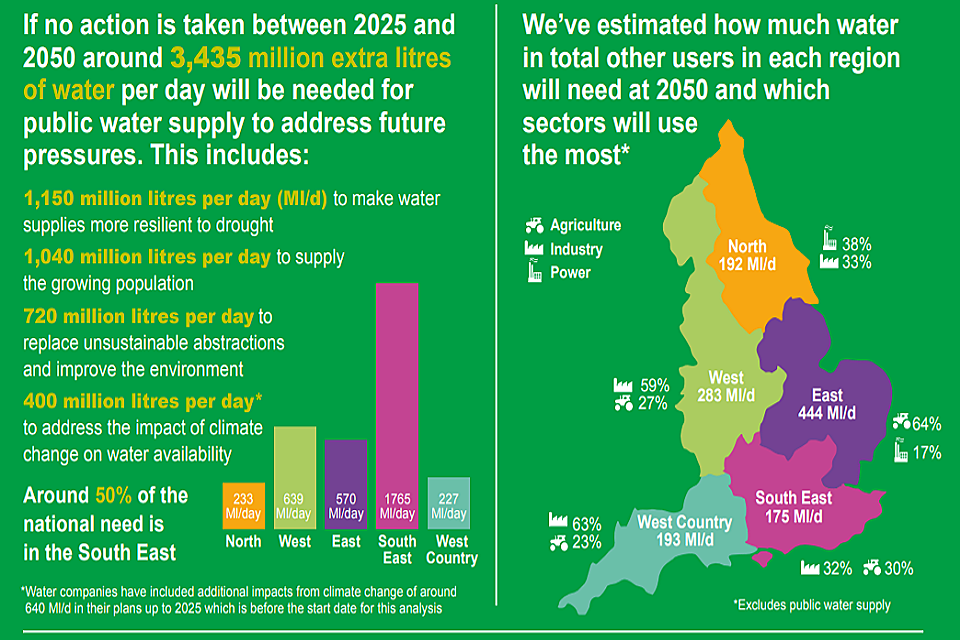Preserving our water resources in a changing climate – industry and government tackle threat to future water supplies
The Environment Agency and partners from across the water industry set out how the action we need to take to meet our future water needs.

Industry and government tackle threat to future water supplies
The Environment Agency has launched a long-term plan for meeting the challenges our water supplies are likely to face as a result of climate change and population growth.
The National Framework for Water Resources, launched today, brings together industry, regulators and government to transform the way we use and look after our water supplies. The framework will help reduce demand, halve leakage rates, develop new supplies, move water to where it’s needed and reduce the need for drought measures that can harm the environment.
The latest predictions estimate that if further action is not taken, between 2025 and 2050 we’ll need more than 3.4 billion additional litres of water per day to meet future demand for public water supply.
The framework looks to ease the pressure on our future water supplies by:
- Reducing demand to an average of 110 litres per person per day by 2050
- Improving water efficiency across all sectors
- Working with water companies to halve leakage rates by 2050
- Developing new supplies such as reservoirs, water re-use schemes and desalination plants
- Making it easier to move water to where it’s needed through regional water transfers
- Reducing the use of drought measures that can impact the environment
The framework introduces an ambitious aim for water companies to help consumers cut wastage and to use water more wisely in order to reduce our average water use from 143 to 110 litres per day.
Five regional groups across the country will work up plans tailored to the specific needs of their individual area, bringing together the 17 English water companies, industry regulators, government and other water users. The framework will guide these groups and deliver a national blueprint for future water resources planning from 2025 to 2050 and beyond.
The framework also sets out the challenges that water-intensive industries such as agriculture and power generation are likely to face across different parts of the country as a result of climate change, and how we can overcome them.
It also sets a greater level of ambition for restoring, protecting and improving the environment that is the source of all our supplies.
Rebecca Pow, Environment Minister, said:
I am pleased to see the Environment Agency challenging water companies to work more collaboratively to increase water efficiency.
This framework is a significant step in the right direction, bringing together consumers, businesses and industry to reduce our water demand, and to put in place the infrastructure we need while preserving our water environment for decades to come.
Emma Howard Boyd, Chair of the Environment Agency, said:
If we don’t take action many areas of England will face water shortages by 2050. The National Framework for Water Resources is the step change required to ensure the needs of all water users are brought together to better manage and share resources. Collaboration is key if we are going to deliver the resilience and environmental enhancement we need.
Dame Kate Barker of the National Infrastructure Commission said:
With demand for water growing and the stability of supply under challenge from climate change, we need a coherent long term plan that ensures England’s water system is resilient to drought while continuing to provide a reliable supply to families and businesses.
We welcome this framework’s bold vision, in line with the conclusions in our National Infrastructure Assessment. It is clear about the need to protect our natural environment and promotes collaboration between water companies, regulators, government and major users to reduce demand, increase supply and better share scarce water resources.
David Black, Senior Director at Ofwat said:
We are acutely aware of the need to secure sustainable long term supply solutions and to reduce the demand for water, which is why we are allowing up to £469 million to help companies work together on solving long-term drought resilience challenges. This provides companies with the resources they need to explore a selection of robust and practical solutions such as building reservoirs, and moving water from the wetter north to the drier south - whilst pushing companies to cut down on leakage.
We will work with the Environment Agency to drive collaboration between industry, regulators and government so that we can all play a part in securing affordable, reliable water services whilst alleviating pressure on the environment and adapting to climate change.
Rob Light, Chair of the Consumer Council for Water, said:
We hope the framework will be a catalyst for the whole sector to unify its efforts in tackling one of the most urgent consumer and environmental challenges of our time – safeguarding the future of our water resources. It’s great we now have a clear plan in place but people will judge the sector on its actions.
Consumers want a safe, reliable supply of water but they also expect water companies to be good stewards of our rivers, streams and natural environment which also depend on there being enough water to survive. All of us have a part to play in the way we use water, but it’s vital we help consumers understand the scale of the problem and the steps that will need to be taken if we want them to be part of the solution.
You can access the full framework document and summary here.

The future pressures on our water environment if no action is taken.
Notes to editors
-
Five regional groups include a wide membership of water users outside the water industry as well as the local water companies. Water company membership is: Water Resources North (Northumbrian Water, Hartlepool (Anglian) Water, Yorkshire Water. Water Resources West (Severn Trent Water, United Utilities, South Staffs Water, Welsh Water). Water Resources East (Anglian Water, Essex and Suffolk Water, Cambridge Water, Severn Trent Water, Affinity Water). Water Resources South East (Affinity Water, Portsmouth Water, South East Water, Southern Water, SES Water, Thames Water). West Country Water Resources (Bristol Water, Wessex Water, South West Water).
-
The National Framework is primarily focused on England as this is the Environment Agency’s remit. However, Welsh Government and Natural Resources Wales have been involved in the work and are represented on the senior steering group. This is to make sure that any proposals that may affect Wales have due regard to the interests of Wales, in particular, sustainable management of its natural resources and welsh legislation and policies. They are also represented in the Water Resources West group.
-
Regional groups will plan to achieve a level of drought resilience so that emergency drought order restrictions, such as providing water only at certain times of the day (rota cuts) or through temporary taps (standpipes) in the streets, are expected to be implemented no more often than once in 500 years on average.